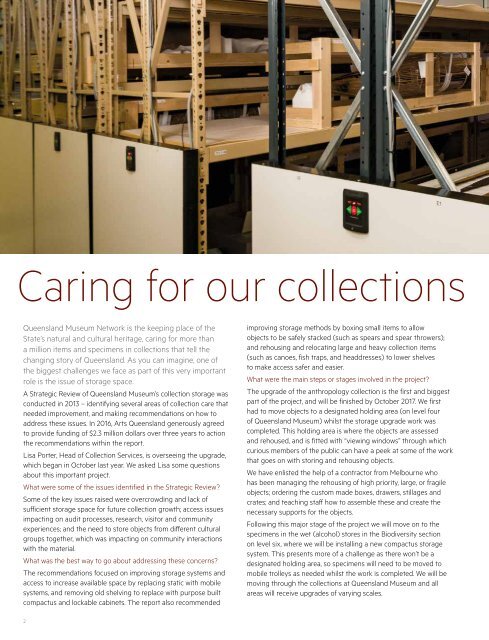QMF_ANTENNA_JUNE_2017_INTERNALS_6_WEB
Create successful ePaper yourself
Turn your PDF publications into a flip-book with our unique Google optimized e-Paper software.
Caring for our collections<br />
Queensland Museum Network is the keeping place of the<br />
State’s natural and cultural heritage, caring for more than<br />
a million items and specimens in collections that tell the<br />
changing story of Queensland. As you can imagine, one of<br />
the biggest challenges we face as part of this very important<br />
role is the issue of storage space.<br />
A Strategic Review of Queensland Museum’s collection storage was<br />
conducted in 2013 – identifying several areas of collection care that<br />
needed improvement, and making recommendations on how to<br />
address these issues. In 2016, Arts Queensland generously agreed<br />
to provide funding of $2.3 million dollars over three years to action<br />
the recommendations within the report.<br />
Lisa Porter, Head of Collection Services, is overseeing the upgrade,<br />
which began in October last year. We asked Lisa some questions<br />
about this important project.<br />
What were some of the issues identified in the Strategic Review?<br />
Some of the key issues raised were overcrowding and lack of<br />
sufficient storage space for future collection growth; access issues<br />
impacting on audit processes, research, visitor and community<br />
experiences; and the need to store objects from different cultural<br />
groups together, which was impacting on community interactions<br />
with the material.<br />
What was the best way to go about addressing these concerns?<br />
The recommendations focused on improving storage systems and<br />
access to increase available space by replacing static with mobile<br />
systems, and removing old shelving to replace with purpose built<br />
compactus and lockable cabinets. The report also recommended<br />
improving storage methods by boxing small items to allow<br />
objects to be safely stacked (such as spears and spear throwers);<br />
and rehousing and relocating large and heavy collection items<br />
(such as canoes, fish traps, and headdresses) to lower shelves<br />
to make access safer and easier.<br />
What were the main steps or stages involved in the project?<br />
The upgrade of the anthropology collection is the first and biggest<br />
part of the project, and will be finished by October <strong>2017</strong>. We first<br />
had to move objects to a designated holding area (on level four<br />
of Queensland Museum) whilst the storage upgrade work was<br />
completed. This holding area is where the objects are assessed<br />
and rehoused, and is fitted with “viewing windows” through which<br />
curious members of the public can have a peek at some of the work<br />
that goes on with storing and rehousing objects.<br />
We have enlisted the help of a contractor from Melbourne who<br />
has been managing the rehousing of high priority, large, or fragile<br />
objects; ordering the custom made boxes, drawers, stillages and<br />
crates; and teaching staff how to assemble these and create the<br />
necessary supports for the objects.<br />
Following this major stage of the project we will move on to the<br />
specimens in the wet (alcohol) stores in the Biodiversity section<br />
on level six, where we will be installing a new compactus storage<br />
system. This presents more of a challenge as there won’t be a<br />
designated holding area, so specimens will need to be moved to<br />
mobile trolleys as needed whilst the work is completed. We will be<br />
moving through the collections at Queensland Museum and all<br />
areas will receive upgrades of varying scales.<br />
2


